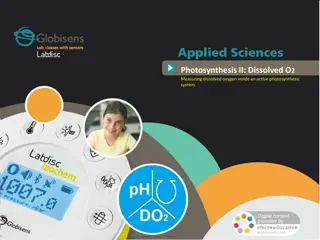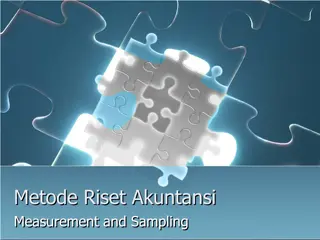Dissolved Oxygen Measurement and Factors Affecting Oxygen Levels
The content highlights the importance of measuring dissolved oxygen levels in water bodies for aquatic life survival. It explains the factors influencing oxygen concentrations, the principles of Winkler's method for measurement, required materials, and the testing procedure involved. The significance of dissolved oxygen testing in evaluating water quality for aquatic organisms is emphasized.
Download Presentation

Please find below an Image/Link to download the presentation.
The content on the website is provided AS IS for your information and personal use only. It may not be sold, licensed, or shared on other websites without obtaining consent from the author. Download presentation by click this link. If you encounter any issues during the download, it is possible that the publisher has removed the file from their server.
E N D
Presentation Transcript
Dissolved Dissolved Oxygen Measurements ( ( Winkler Oxygen Measurements Winkler s Method) s Method) Amal Almuhanna 2012
*Factors Affecting Oxygen Levels 1)Oxygen is removed from the water by chemical reactions, the decay process and respiration. 2)Water temperature and atmospheric pressure affect oxygen concentration in water. 3) Cold water at high atmospheric pressure holds more dissolved oxygen than warm water at low atmospheric pressure. 4) Degree of light penetration (turbidity, color and water depth) and the degree of water turbulence or wave action also affect oxygen concentrations. Dissolved oxygen (D.O.) is reported as milligrams of oxygen per liter of water (mg/L) . Aquatic plants produce oxygen by photosynthesis during daylight hours but they also use oxygen for respiration.
*Introduction *Both plants and animals depend on dissolved oxygen for survival. *lack of oxygen can kill aquatic plants and animals. * Measuring dissolved oxygen is probably the most significant water quality test to determine the suitability of a stream for fish and many other aquatic organism to determine the suitability of a stream for fish and many other aquatic organisms. s.
*Principles of Winklers Method Oxygen combines with Mangnous hydroxide hydroxides, which on acidification liberate iodine equivalent to that of oxygen fixed. This iodine is titrated by standard Sodium thiosulfate starch as an indicator. Mangnous hydroxide to form higher standard Sodium thiosulfate solution using
*Materials 1)Water Samples. 2)Sodium thiosulfate titrant (0.025). 3)Narrow mouth 250 ml BOD bottles. 4)Sulfuric acid (concentrated) 5)Starch indicator. 6)Manganous sulfate solution 7)Alkaline- potassium iodide 8)Pipettes, Flasks
Procedure cont. A. A.Collecting B. B.Testing for Dissolved Oxygen 1. Remove the stopper and add 1 ml Manganous sulfate. 2. Add 3 ml alkaline potassium iodide into the sample and insert the stopper, and shake vigorously, holding on to the top. If oxygen is present, a brownish-orange precipitate will form. 3. Allow the sample to stand until the precipitate settles halfway. Collecting the Testing for Dissolved Oxygen the Sample Sample
4) Remove the stopper and slowly add 2 ml sulfuric acid. Insert the stopper and shake vigorously to dissolve the precipitate. 5) Shake and wait until all the precipitate is dissolved. The yellow color is from iodine. 6) Take a suitable aliquot 200 ml in a flask and titrate with Sodium thiosulfate solution till the colour changes to very light yellow. 7) Add 3ml of starch solution. The prepared sample will turn blue from the added starch solution. 8) Continue adding drops and mixing until the prepared sample turns from blue to colorless (the end point
*Results Analysis Sample no. ml of Sample ml of titrant used D.O. mg l -1 1- 2- 3- 4- 5- 6- 7-
*Calculation Science 1 ml of 0.025 N sodium thiosulfate is equivalent to 0.2 mg oxygen. D.O. mg l D.O. mg l - -1 1 = ( = (8 8X X1000 1000XN V XN) X v ) X v Where: V V= volume of sample v v= volume of titrant used (ml) N= normality of the titrant Result. Express D.O. in mg l 1 Where:- -























